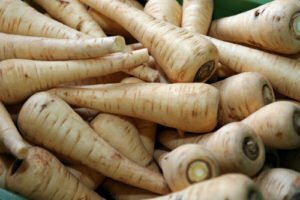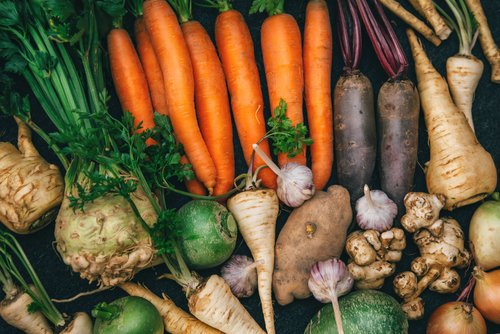
What is a root vegetable?
The term root vegetable is generically used for plants where the root is eaten as a vegetable. In this context, the word ‘root’ is used to refer to the belowground part of the plant. However, it is not necessarily a root in the botanical sense. The common aspect of root vegetables is that the root part is generally a storage organ, enlarged to store energy in the form of carbohydrates. However, botany categorises root vegetables into two distinct groups, which are ‘true roots’ and ‘non-roots’. True roots are sub-divided into; taproots and tuberous roots, and non-roots into; bulbs, corms, rhizomes, and tubers.
Root vegetables come from a diverse range of plant species, for example; potatoes are part of the Nightshade family, carrots are from the Parsley family (aka umbellifers) and turnips are a variety of Brassica. Some of the more exotic plant types that classify as root vegetables include; cassava, ginger, ginseng, galangal, sweet potato and yams.
Growing root vegetables
Most amateur gardeners will find that root vegetables are extremely cheap and easy to grow. For instance, some popular varieties of carrots sell for as little as £1 (US$1.3) per 2000 seeds (2020). And, once the seedlings are planted they require very little attention other than an occasional bout of weeding.
Here’s the Fivemiutesspare concise guide to growing some of the most popular root vegetables that flourish in a temperate climate. The narrative is directed at growing popular root vegetables outdoors from seed in UK conditions. Stated advice on seeding and harvesting is conditional on expected seasonal weather patterns in the UK, which may also apply to other countries in the northern hemisphere with temperate climates.
Beetroot (Beet)
- Beetroot will grow best in well-drained, fertile soil that has been enhanced with either well-rotted garden compost or manure.
- For early outdoor sowing in mid-March, a warm, sheltered spot will be required, otherwise leave sowing to mid-April at the earliest, with any successive sowing no later than early July.
- Drills should be 1’’ (25 mm) deep and about 12’’ (300 mm) apart and receive 3 seeds. If all 3 seeds germinate then reduce to one, which is best done when the soil is damp and the plants about 1’’ (25 mm) high. Quick growth can be encouraged by plenty of watering and a surface dressing of agricultural salt in June and July will also help.
- Harvesting for beetroot is from June onwards.
Popular Varieties:
- Subeto – uniform, deep crimson root, with excellent resistance to disease.
- Bettollo – sweet due to high sugar content, can be picked early as baby beet or left to mature for a larger sized crop.
- Boltardy – the UK’s best-loved beet, can be sown early and does well in most soils.
Carrots
- Ideally, carrots should be grown in deep, fertile, slightly sandy soil. If your soil is a little stony, then best to grow short-rooted varieties.
- The soil only needs to be manured several weeks before sowing.
- Early varieties of carrots can be sown in a prepared seedbed as early as February. However, they may need some protection against frost or if possible sow in a ‘warm’ part of the garden.
- Sow 2 or 3 seeds to a depth of ½’’ in a single drill, at 6’’ intervals, then cover with a thin layer of fine (sieved, if necessary) soil.
- When seedlings reach about 1’’ high, thin out to a single plant. The same variety of seeds can be sown as late as July to produce Autumn crops but later sown seeds should be in drills 12’’ apart.
- The main crop seeding dates for carrots are March to May, with harvesting being between August and November.
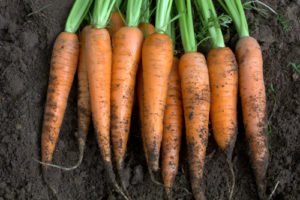
Popular Varieties:
- Nandor – quick maturing carrot with good resistance to carrot fly.
- Nantes – a classic early carrot but can be sown throughout the growing season.
- Autumn King – a popular maincrop variety that keeps well in the ground until required.
Parsnips
- Parsnips will give the best yield if they are given a sunny plot in the well-dug ground to a depth of around 18 ”. They generally do well in soils where other vegetables have just been grown.
- A generous dressing of wood ash or sulphate of potash is recommended for all soil types.
- Sow seeds from February to April. Soak seeds for 24 hours before planting directly outdoors. Sow 5 or 6 seeds in groups 1’’ deep, at 12” intervals, in rows 15” apart.
- Seedlings will emerge in 4 to 6 weeks. When they are about 2’’ (50 mm) high, thin out to a single plant. Take care to make sure the remaining plants are left in firm ground.
- Hoe regularly, to keep down weeds and to keep the bed soil crumbly.
- For increased chances of large crops, apply a dose of superphosphate about a month after thinning out and then again 6 weeks later.
- Harvest parsnips between August and March. For the best-tasting crop, harvest before the ground freezes. If you leave the crop in the ground through winter, cover them with a thick layer of organic mulch. Harvest immediately after the ground thaws in the spring.
Popular Varieties:
- Gladiator – very popular, sweet flavoured variety with good resistance to canker.
- Countess – usually produces a uniform, sweet flavoured, high yielding crop, with good resistance to disease.
- Javelin – a smooth-skinned variety that roasts well, with good canker resistance.
Radish
- Radish thrives in well-drained, stone-free, soil that has recently had compost dug in. Ideally, choose a sunny spot in the garden that has a little shade as your bed.
- Due to its quick-growing nature, it’s usually best to grow radish in relatively small quantities.
- Sowings, depending on variety, can be made from February to September. Early sowings should be made in a sheltered spot in the garden and protected from frost until seedlings show.
- Sow seeds singularly at 1’’ (25 mm) intervals in rows 6’’ (150 mm) apart for summer varieties and 10’’ (250 mm) for the larger winter varieties. Cover seeds with 1/2’’ (13 mm) of fine soil.
- Make sure the ground is kept well watered for spring and summer sowings. Winter sowings can be made from late July through to September.
- When seedlings reach 1” (25 mm) in height, thin out to 3” (75 mm) and 6” (150 mm) spacings for summer and winter varieties, respectively. Carry out thinning in moist soil conditions to minimise disturbance.
- Expect summer varieties to mature in about 20 to 45 days and winter varieties in 45 to 70 days. Summer varieties can be harvested from March to October and winter varieties from October onwards.
- Pick spring varieties as soon as they reach the preferred size and before they become tough and pithy. Winter varieties will keep adequately in the ground for a few weeks after maturity, in cool weather.
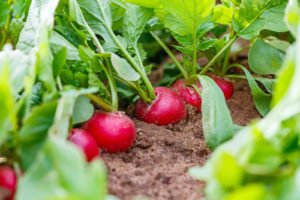
Popular Varieties:
- Scarlet Globe – classic spherical, well flavoured, crispy radish.
- Escala – usually grows well even in poor soils, producing a root of good texture and flavour.
- Sparkler – a reliable, fast-growing, mild flavoured root.
Turnips
- Turnips will thrive in soil that is lump free to a depth of 12” (300 mm) and has been recently enriched with either old manure or well-rotted compost.
- Plants require a constant supply of moisture so make sure any dry ground has a shady disposition.
- Soaking seeds for 24 hours before sowing will hasten germination.
- Seeds can be sown as early as mid-March if they are in a protected spot, but more normally in April and May. Sow seeds thinly 1/2” deep drills about 9” apart.
- Sowings can be made in June or even early July but have less chance of success. Sow winter varieties mid-August to September.
- Make sure seedlings are kept well watered through any dry periods.
- Thin out seedlings to 3” spacings in the first instance, and then the final 6” spacing, at the second attempt.
- Harvest early types after about 5 weeks; maincrop types after 6 to 10 weeks. Harvesting can be of any size, however, small, young turnips are more tender.
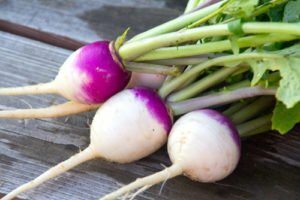
Popular Varieties:
- Sweet Bell – very sweet flavoured, firm-textured, clear white root, that grow to around 3” dia.
- Purple top Milan – classic flat-topped turnip with white flesh, best harvested when young.
- Oregon – a yellow hybrid variety that does well as an early crop
f you’ve enjoyed reading this article, why not click on the link to Hobbies and Pastimes, to see if there’s anything else that takes your interest?
